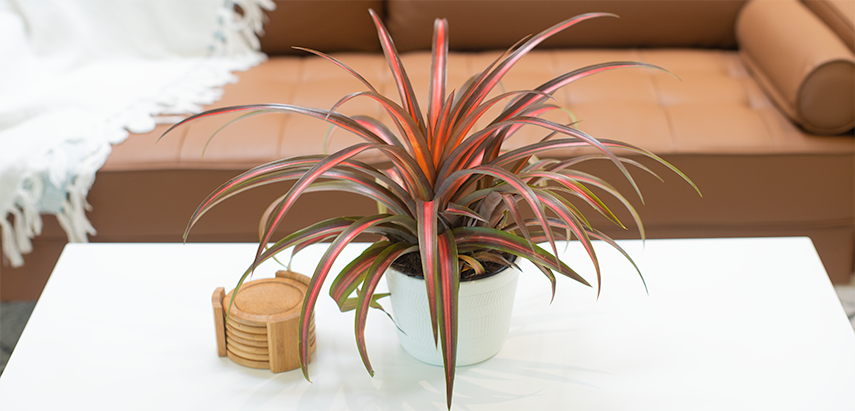Pineapple (Ananas spp.)
Pineapple Plant Features
Add a splash of texture to your home or office with a pineapple. These indoor plants have a bold look that sets them apart from most other houseplants. Plus, their relatively low water needs make them easy to care for if you have a bright spot. Selections that have variegated foliage, such as Pink Starburst, are perfect additions to bright desks and tabletops.Pineapples offer stiff foliage that complements many dracaena varieties, as well as other bromeliads (including Guzmania and Vriesea varieties). Or use the leaves to contrast more lush houseplants such as bird of paradise, croton, or monstera. Pink Starburst pineapple can make for a lovely accent to other pink-variegated houseplants, including Red Ruby ficus, Red Sister cordyline, or Ultra Pink Aglaonema.
Because the foliage is stiff and spiky, it's best to keep pineapples in an out-of-the-way spot out of reach of children and pets.
Depending on the variety, pineapple plants can grow 1 to 4 feet tall and wide indoors.
Pineapple Growing Instructions
LightAs houseplants, pineapples like lots of bright light, so situate them where they'll cast a strong shadow for at least several hours of the day. If acclimated, they can tolerate direct sun through a window, but they're not sufficiently acclimated, provide a sheer curtain or frosted window sticker to diffuse the light. If you don't have an abundance of natural light, you can grow pineapples under plant lights.
Tip: Variegated varieties show best variegation in bright light. If they don't receive enough illumination, the variegation may fade.
Water
In general, you'll want to water your pineapple as the top 2 to 3 inches of the potting mix dries to the touch when you grow it as an indoor plant. If you're not sure whether your pineapple needs water, it's usually better to wait a day or two. These plants are better at surviving being too dry than staying too wet. If they get more water than they need, the roots may suffocate, die, and rot.
Humidity
Pineapples thrive in average to above-average home conditions. That said, your pineapple may appreciate boosting the amount of moisture in the air, particularly if you live in an arid climate. Easy ways to do this are to place a small humidifier in the room with the plant or group it with other houseplants, which naturally release moisture through their foliage.
Fertilizing
Inside, pineapples aren't particularly hungry plants. You can fertilize them as little as adding some time-release fertilizer once or twice a year. Spring and summer are the best months to do this. If you want to make your plant grow bigger/faster, you can fertilize more regularly with a water-soluble fertilizer. No matter what type of fertilizer you use, be sure to follow the instructions on the product packaging. Never exceed the recommended application rates.
Pruning
Good news! No pruning is necessary except to remove any old or damaged leaves.
Note: Our pineapples are grown for ornamental use and are not intended for human or animal consumption.
-
Water
Low water needs
-
Light
Indoors: High light
-
Colors
Green
Pink
Variegated
-
Special Features
Purifies the air
Super-easy to grow
Complement your Pineapple
Snake PlantSnake plant has an upright habit that creates a lovely contrast to pineapple's more strappy leaves.
Ponytail Palm
Ponytail palm makes for an elegant accent to pineapple plants.
Q&A
Will Pink Starburst pineapple produce a fruit I can eat?This variety has been bred for its attractive ornamental foliage and does not produce a quality fruit. Enjoy it for its lovely looks!

